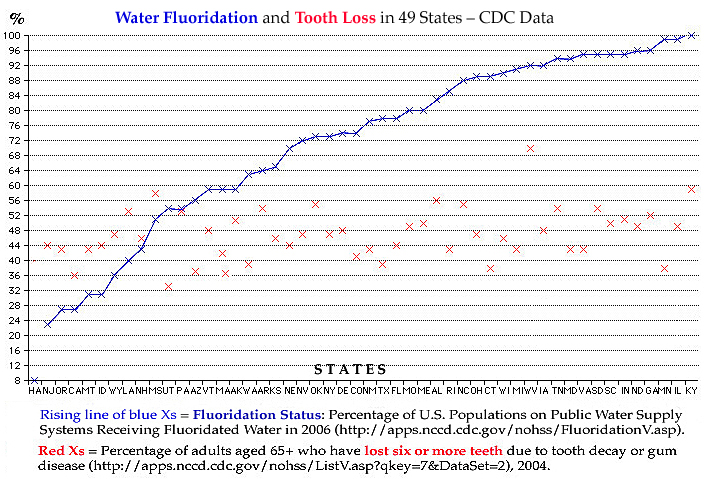
Data for 49 states shown in this chart come from two separate documents
published by the U.S. Centers for Disease Control & Prevention:
1) "Adults aged 65+ who have lost six or more teeth due to tooth decay or gum disease" (2004).
The third most common cause of tooth loss is fractured teeth. Bill Osmunson, DDS, MPH (who practices dentistry in both Oregon and Washington) sees a connection between water fluoridation and tooth fracture. See his compelling research about tooth fracture in "Water fluoridation intervention: dentistry's crown jewel or dark hour" (Fluoride, Oct-Dec 2007).
Dental Fluorosis, Tooth Loss and Kidney Disease
Results from a 2007 study "suggest that drinking-water fluoride levels over 2.0 mg/L [2 ppm] can cause damage to liver and kidney functions in children and that the dental fluorosis was independent of damage to the liver but not the kidney." ("Dose-effect relationship between drinking water fluoride levels and damage to liver and kidney functions in children," Environ Res. 2007 Jan;103(1):112-6.)
|
What's Lead Got to Do with It?
Small amounts of lead may damage children's kidneys.
– Archives of Internal Medicine, January 11, ,2010 |
The American Journal of Kidney Diseases reported in January 2008 that people with missing teeth are 85% more likely to have chronic kidney disease.
What is fluoride's connection? This is an area researchers ought to focus on because "an estimated 26 million people, about 13% of the U.S. population, now have chronic kidney disease... but most remain unaware of it." (National Institute of Diabetes and Digestive and Kidney Diseases, 2007)
Another connection: elderly women with moderate kidney dysfunction are considerably more likely to experience hip fracture than those without impaired kidneys. (Archives of Internal Medicine, January 26, 2007)
See other research into the health effects of fluoride on the kidneys.
A national oral health report card for 2001-2002 showed more tooth loss in fluoridated states. See an Analysis of Oral Health America data by Hardy Limeback, BSc PhD DDS, Head, Preventive Dentistry, Faculty of Dentistry, University of Toronto.
The 2000 Oral Health Report Card also showed that fluoridated water didn't necessarily reduce tooth loss or on tooth decay.
Find your state data for rates of fluoridation and diseases in one table.
Charts of CDC data show statistical associations
between states' fluoridation rates and adverse health effects.
Water Fluoridation – Sales Pitch vs. Reality Check
is a comprehensive 2008 report by John D. MacArthur
whose recent comments to EPA summarize epidemiological data
suggesting millions of Americans are suffering adverse health conditions
resulting from the failure to properly regulate fluoride in drinking water.
This page revised July 12, 2010.